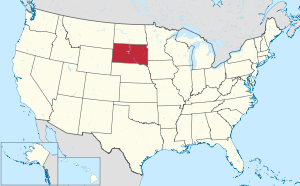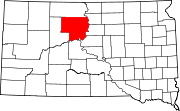County in South Dakota
| Dewey County | |
|---|---|
| County | |
 Forest City Bridge Forest City Bridge | |
 Location within the U.S. state of South Dakota Location within the U.S. state of South Dakota | |
 South Dakota's location within the U.S. South Dakota's location within the U.S. | |
| Coordinates: 45°10′N 100°53′W / 45.16°N 100.88°W / 45.16; -100.88 | |
| Country | |
| State | |
| Founded | 1883 (created) 1910 (organized) |
| Named for | William P. Dewey |
| Seat | Timber Lake |
| Largest community | North Eagle Butte |
| Area | |
| • Total | 2,445 sq mi (6,330 km) |
| • Land | 2,302 sq mi (5,960 km) |
| • Water | 143 sq mi (370 km) 5.8% |
| Population | |
| • Total | 5,239 |
| • Estimate | 5,208 |
| • Density | 2.1/sq mi (0.83/km) |
| Time zone | UTC−7 (Mountain) |
| • Summer (DST) | UTC−6 (MDT) |
| Congressional district | At-large |
Dewey County is a county in the U.S. state of South Dakota. As of the 2020 census, the population was 5,239. Its county seat is Timber Lake. The county was created in 1883 and organized in 1910. It was named for William P. Dewey, Territorial surveyor-general from 1873 to 1877.
Almost the entire county lies in the Cheyenne River Indian Reservation. The balance of the county, along its extreme northern county line, lies in the Standing Rock Indian Reservation. It is one of five South Dakota counties that are contained within Indian reservations.
Geography
The Moreau River flows east-northeasterly through the upper central parts of Dewey County, discharging into the Missouri River near the county's NE corner. Smaller drainages move runoff water northward from the central-eastern portions to the Missouri River, discharging near the community of Promise. A significant arm of the Missouri River forms the county's southeastern border. The county terrain consists of rolling hills, sloping southeastward and dropping off into the Missouri River basin.
The county has a total area of 2,445 square miles (6,330 km), of which 2,302 square miles (5,960 km) is land and 143 square miles (370 km) (5.8%) is water.
The eastern portion of South Dakota's counties (48 of 66) observe Central Time; the western counties (18 of 66) observe Mountain Time. Dewey County is the easternmost of the SD counties to observe Mountain Time.
Major highways
Adjacent counties
- Corson County – north
- Walworth County – northeast (observes Central Time)
- Potter County – east (observes Central Time)
- Sully County – southeast (observes Central Time)
- Stanley County – south
- Ziebach County – west
Protected Areas
- Firesteel Dam State Game Production Area
- Isabel Lake State Game Production Area
- Little Moreau State Game Production Area
- Little Moreau State Recreation Area
Lakes
- Lake Isabel
- Lake Oahe (partial)
- Little Moreau Lake
Demographics
| Census | Pop. | Note | %± |
|---|---|---|---|
| 1910 | 1,145 | — | |
| 1920 | 4,802 | 319.4% | |
| 1930 | 6,476 | 34.9% | |
| 1940 | 5,709 | −11.8% | |
| 1950 | 4,916 | −13.9% | |
| 1960 | 5,257 | 6.9% | |
| 1970 | 5,170 | −1.7% | |
| 1980 | 5,366 | 3.8% | |
| 1990 | 5,523 | 2.9% | |
| 2000 | 5,972 | 8.1% | |
| 2010 | 5,301 | −11.2% | |
| 2020 | 5,239 | −1.2% | |
| 2023 (est.) | 5,208 | −0.6% | |
| U.S. Decennial Census 1790-1960 1900-1990 1990-2000 2010-2020 | |||
2020 census
As of the 2020 census, there were 5,239 people, 1,705 households, and 1,180 families residing in the county. The population density was 2.3 inhabitants per square mile (0.89/km). There were 1,923 housing units.
2010 census
As of the 2010 census, there were 5,301 people, 1,730 households, and 1,239 families in the county. The population density was 2.3 inhabitants per square mile (0.89/km). There were 2,002 housing units at an average density of 0.9 units per square mile (0.35 units/km). The racial makeup of the county was 74.9% American Indian, 21.0% white, 0.2% Asian, 0.1% black or African American, 0.2% from other races, and 3.6% from two or more races. Those of Hispanic or Latino origin made up 1.8% of the population. In terms of ancestry, 13.2% were German, 6.5% were Irish, and 0.6% were American.
Of the 1,730 households, 45.9% had children under the age of 18 living with them, 37.6% were married couples living together, 24.2% had a female householder with no husband present, 28.4% were non-families, and 24.6% of all households were made up of individuals. The average household size was 3.05 and the average family size was 3.60. The median age was 30.0 years.
The median income for a household in the county was $33,255 and the median income for a family was $40,500. Males had a median income of $33,942 versus $28,594 for females. The per capita income for the county was $15,632. About 20.5% of families and 30.5% of the population were below the poverty line, including 39.5% of those under age 18 and 13.5% of those age 65 or over.
Communities
Cities
- Eagle Butte (partial)
- Timber Lake (county seat)
Town
Census-designated places
Unincorporated communities
Unorganized territories
The county is divided into two areas of unorganized territory: North Dewey and South Dewey.
Politics
Dewey has since the 1990s been a strongly Democratic county in solidly Republican South Dakota. The last Republican to carry the county was Ronald Reagan in his 1984 landslide when he came within 3,761 votes of claiming all fifty states. Before this period, by contrast, Dewey was a Republican-leaning county even for South Dakota. Between its formation and 1984, Dewey had voted Democratic only in the three landslide Democratic wins of 1964, 1936 and 1932, plus for Woodrow Wilson in 1916 when his anti-war policies had strong appeal in the West.
| Year | Republican | Democratic | Third party(ies) | |||
|---|---|---|---|---|---|---|
| No. | % | No. | % | No. | % | |
| 2024 | 793 | 42.38% | 1,032 | 55.16% | 46 | 2.46% |
| 2020 | 790 | 40.18% | 1,131 | 57.53% | 45 | 2.29% |
| 2016 | 723 | 42.33% | 888 | 51.99% | 97 | 5.68% |
| 2012 | 663 | 34.99% | 1,207 | 63.69% | 25 | 1.32% |
| 2008 | 659 | 32.64% | 1,328 | 65.78% | 32 | 1.58% |
| 2004 | 921 | 35.92% | 1,606 | 62.64% | 37 | 1.44% |
| 2000 | 761 | 45.27% | 880 | 52.35% | 40 | 2.38% |
| 1996 | 657 | 33.20% | 1,114 | 56.29% | 208 | 10.51% |
| 1992 | 642 | 36.64% | 766 | 43.72% | 344 | 19.63% |
| 1988 | 765 | 42.76% | 1,007 | 56.29% | 17 | 0.95% |
| 1984 | 941 | 54.49% | 772 | 44.70% | 14 | 0.81% |
| 1980 | 1,045 | 59.14% | 600 | 33.96% | 122 | 6.90% |
| 1976 | 820 | 53.46% | 706 | 46.02% | 8 | 0.52% |
| 1972 | 1,008 | 58.88% | 699 | 40.83% | 5 | 0.29% |
| 1968 | 941 | 52.72% | 721 | 40.39% | 123 | 6.89% |
| 1964 | 981 | 43.79% | 1,259 | 56.21% | 0 | 0.00% |
| 1960 | 1,168 | 52.80% | 1,044 | 47.20% | 0 | 0.00% |
| 1956 | 1,197 | 56.76% | 912 | 43.24% | 0 | 0.00% |
| 1952 | 1,301 | 66.34% | 660 | 33.66% | 0 | 0.00% |
| 1948 | 864 | 53.80% | 727 | 45.27% | 15 | 0.93% |
| 1944 | 913 | 64.12% | 511 | 35.88% | 0 | 0.00% |
| 1940 | 1,396 | 56.36% | 1,081 | 43.64% | 0 | 0.00% |
| 1936 | 1,012 | 44.25% | 1,216 | 53.17% | 59 | 2.58% |
| 1932 | 710 | 30.51% | 1,591 | 68.37% | 26 | 1.12% |
| 1928 | 1,293 | 56.39% | 996 | 43.44% | 4 | 0.17% |
| 1924 | 956 | 53.05% | 222 | 12.32% | 624 | 34.63% |
| 1920 | 880 | 63.31% | 335 | 24.10% | 175 | 12.59% |
| 1916 | 352 | 47.00% | 379 | 50.60% | 18 | 2.40% |
| 1912 | 0 | 0.00% | 411 | 42.20% | 563 | 57.80% |
See also
References
- ^ "State & County QuickFacts". United States Census Bureau. Retrieved March 21, 2024.
- "Find a County". National Association of Counties. Archived from the original on May 31, 2011. Retrieved June 7, 2011.
- "Dakota Territory, South Dakota, and North Dakota: Individual County Chronologies". Dakota Territory Atlas of Historical County Boundaries. The Newberry Library. 2006. Archived from the original on April 2, 2018. Retrieved March 29, 2015.
- Gannett, Henry (1905). The Origin of Certain Place Names in the United States. Govt. Print. Off. p. 105.
- ""Find an Altitude" Google Maps (accessed February 2, 2019)". Archived from the original on May 21, 2019. Retrieved February 2, 2019.
- "2010 Census Gazetteer Files". United States Census Bureau. August 22, 2012. Retrieved March 24, 2015.
- "Time Zones Map in South Dakota, USA". Timebie. Retrieved April 27, 2024.
- "County Population Totals and Components of Change: 2020-2023". Retrieved March 17, 2024.
- "U.S. Decennial Census". United States Census Bureau. Retrieved March 24, 2015.
- "Historical Census Browser". University of Virginia Library. Retrieved March 24, 2015.
- Forstall, Richard L., ed. (March 27, 1995). "Population of Counties by Decennial Census: 1900 to 1990". United States Census Bureau. Retrieved March 24, 2015.
- "Census 2000 PHC-T-4. Ranking Tables for Counties: 1990 and 2000" (PDF). United States Census Bureau. April 2, 2001. Archived (PDF) from the original on October 9, 2022. Retrieved March 24, 2015.
- "US Census Bureau, Table P16: Household Type". United States Census Bureau. Retrieved March 21, 2024.
- Bear Creek SD Google Maps (accessed February 2, 2019)
- Parade SD Google Maps (accessed February 2, 2019)
- Promise SD Google Maps (accessed February 2, 2019)
- Leip, David. "Atlas of US Presidential Elections". uselectionatlas.org. Retrieved April 15, 2018.
| Places adjacent to Dewey County, South Dakota | ||||||||||||||||
|---|---|---|---|---|---|---|---|---|---|---|---|---|---|---|---|---|
| ||||||||||||||||
| Municipalities and communities of Dewey County, South Dakota, United States | ||
|---|---|---|
| County seat: Timber Lake | ||
| Cities |  | |
| Town | ||
| CDPs | ||
| Other communities | ||
| Indian reservations | ||
| Footnotes | ‡This populated place also has portions in an adjacent county or counties | |
45°10′N 100°53′W / 45.16°N 100.88°W / 45.16; -100.88
Categories: